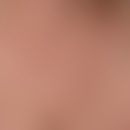Synonym(s)
DefinitionThis section has been translated automatically.
Compared to contact-allergic "dermatitis" in other localizations, contact-allergic, itchy dermatitis of the (hairy) scalp is rather rare, acute or chronic. The rather rare infestation of the hairy scalp is possibly due to the special anatomical or immunological architecture of the scalp with its numerous hair follicles.
EtiopathogenesisThis section has been translated automatically.
The triggers are manifold.
Hair dyes: The vast majority of all scalp contact allergies are caused by ingredients of hair dyes and bleaches, shampoos and medical products. The most important contact allergens are: para-phenyldiamine, para-toluyendiamine, 4-amine o-2-hydroxytoluene, para-aminophenol, 3-aminophenol, pyrrogallol. These substances are all contained in the common DKG hairdressing product lines.
Bleaching agents (ammonium persulfate) and perming products: ammonium thioglycolate.
Shampoos: A variety of allergens have been described in shampoos (Zirwas M et al. 2007): fragrances (95%), cocamidopropyl betaine 53%), methylchloroisothiazolinones/methylisothiazolinones (51%), formaldehyde releasing substances (48%), propylene glycol (38%), vitamin E (28%), parabens (24%), etc.
Other allergens:
Hair conditioners: Here the contact allergens listed in the shampoos are possible. Additionally, contact allergic reactions to glutaraldehyde and panthenol have been described. Argan oil is increasingly used for hair cosmetics due to its high content of phytosterols and unsaturated fatty acids. Cases of contact allergies have been described.
Adhesives (after hair extensions)
Scalp therapeutics: From the point of view of contact allergy, shampoos containing polidocanol and zinc-pyrithione anti-dandruff shampoos should be mentioned. Diclofenac (therapeutic agent for the treatment of actinic keratoses; diclofenac can also cause photoallergic and phototoxic reactions) Diphenylcyclopropenone (DPCP) in the (now rare) treatment of Alopecia areata
You might also be interested in
ClinicThis section has been translated automatically.
In the acute inflammatory phase, the hairy scalp and other points of contact with the allergen cause severe itching, redness, oedema or even weeping of the skin. Vesicles (occasionally follicular pustules atypical for an eczema reaction) are rarely seen.
Swelling of the eyelid is often the initial symptom of contact allergic reactions of the hairy scalp. They may dominate the clinical picture (differential diagnosis: angioedema as false diagnosis).
Not infrequently, scattered reactions and extensive redness are found in the forehead area as well as in other peripheral areas of the hairy scalp. Stronger allergic reactions of the scalp often cause a pronounced telogen effluvium, which stops after the noxious agent is switched off.
Chronic allergic scalp dermatitis is characterized by itching, extensive redness and scaling of the scalp.
DiagnosisThis section has been translated automatically.
Typical clinical picture as well as the anamnestic data with the temporal and local connection to the application of the responsible allergen.
Differential diagnosisThis section has been translated automatically.
- Irritant toxic contact dermatitis of the scalp (negative epicutaneous test)
- Pyoderma of the scalp
- Toxic (toxic-irritative) eczema of the scalp
- pediculosis capitis
- Seborrhoeic eczema of the scalp (see below seborrhoeic eczema)
- psoriasis capitis
- tinea capitis
TherapyThis section has been translated automatically.
The procedure for acute contact-allergic eczema of the (hairy) scalp is basically no different from that for contact-allergic eczema of the rest of the integument.
In the foreground is a stage-appropriate application of topical glucocorticoids, mostly in a washable cream base.
Only in cases of pronounced clinical inflammatory symptoms a systemic therapy with medium doses of a glucocorticoid (e.g. 100 mg prednisolone i.v.) in combination with an antihistamine (e.g. loratadine) is necessary.
Note(s)This section has been translated automatically.
Common causes of contact allergy of the capillitium:
- Application of hair shampoos and hairdressing products, here mostly in connection with a permanent wave or dyeing process. The most common allergens are:
- Bleaching agent (ammonium persulphate)
- Fragrances (see below fragrance mix)
- Hair dyes (p-phenyldiamine, toluenediamine - see below contact allergens)
- Perm products (ammonium thioglycolate)
- Preservatives (e.g. parabens)
- Cocamidopropylbetaine (contained in hair shampoos)
- Adhesives (after hair extensions)
- Therapeutics that are mainly used on the capillitium:
- Diclofenac (therapeutic agent for the treatment of actinic keratoses; diclofenac may also cause photoallergic and phototoxic reactions)
- Diphenylcyclopropenone (DPCP) in the treatment of Alopecia areata
LiteratureThis section has been translated automatically.
Barrientos N et al (2014) Allergic contact dermatitis caused by argan oil in an infant. Contact dermatitis 71:316-317.
Buchanan R et al (2014) Extensive scalp angioedema following high-dose diphenylcyclopropenone for alopecia areata. Hosp Pharm. 49:48-51
Genderen van ME et al (2014) Severe facial swelling in a pregnant woman after using hair dye. BMJ Case Rep doi: 10.1136/bcr-2013-202562.
Gokalp H et al (2014) Angioedema-like allergic contact dermatitis related to black henna. Dermatol Online J 20th PubMed PMID: 24612582
Hillen U et al (2007) Patch test results in patients with scalp dermatitis: analysis of data from the Information Network of Departments of Dermatology. Contact Dermatitis 56:87-93.
Koch E et al (2017) Contact allergy of the scalp. dermatologist 68: 466-471
Wilsmann-Theis D et al (2014) Psoriasis and eczema on the capillitium. Dermatologist 64: 1043-1049
Zirwas M et al (2009) Shampoos. Dermatitis 20:106-110.
Outgoing links (13)
Argan oil; Contact allergens; Diclofenac; Diphenylcyclopropenone (dpcp); Effluvium; Fragrances (overview); Hairdressing supplies; Loratadine; Pediculosis capitis; Polidocanol; ... Show allDisclaimer
Please ask your physician for a reliable diagnosis. This website is only meant as a reference.








